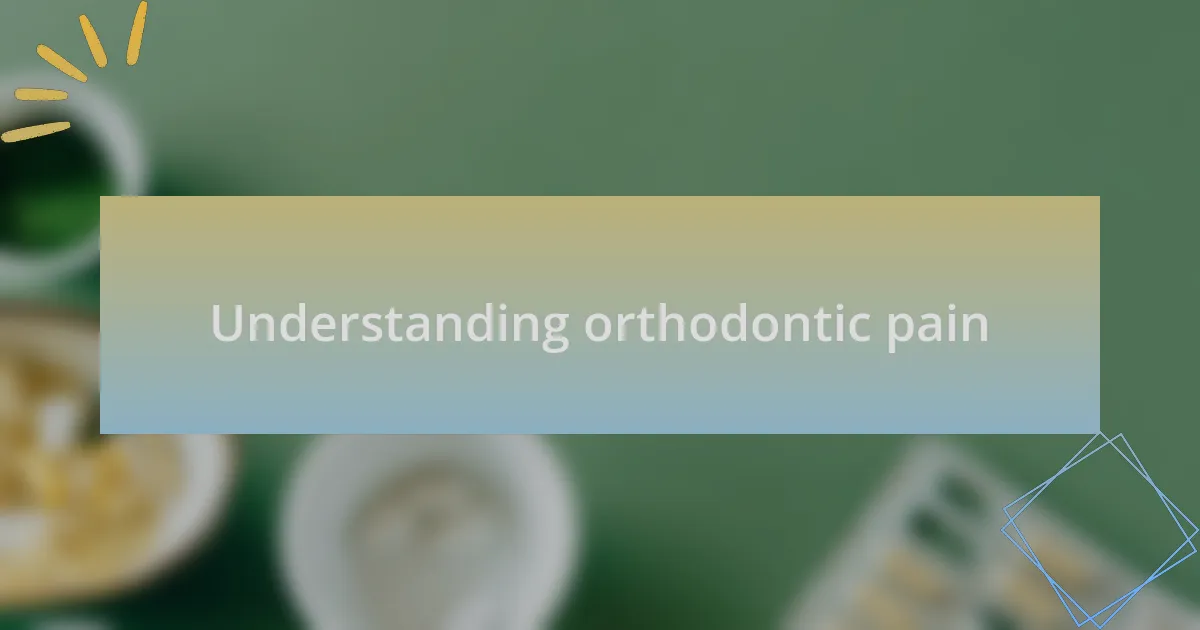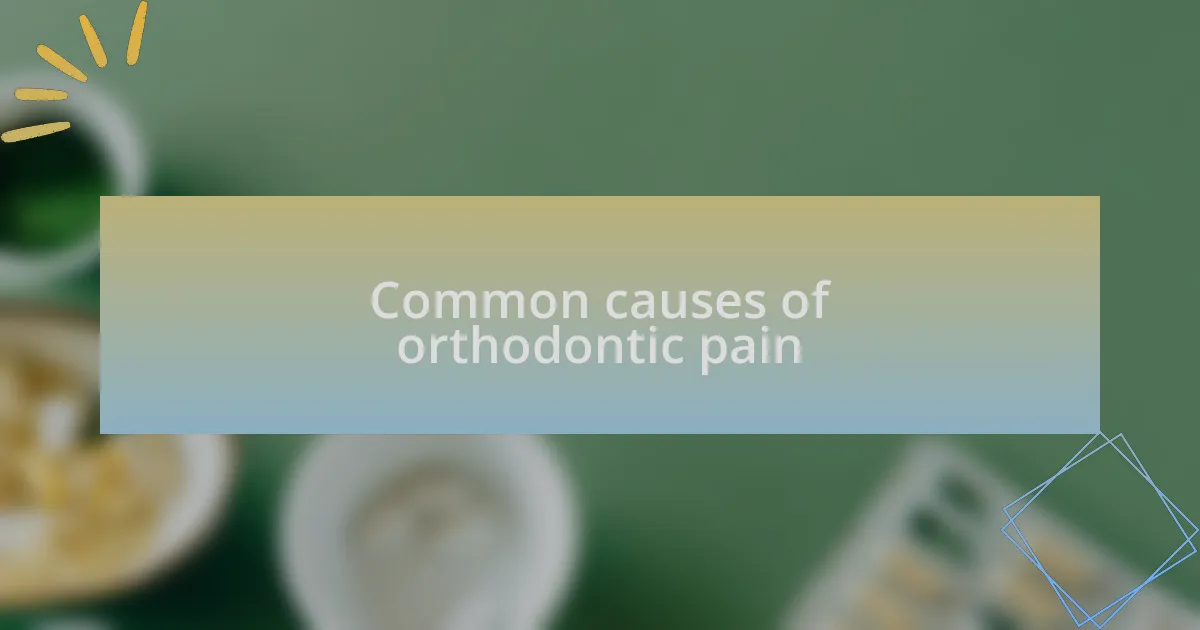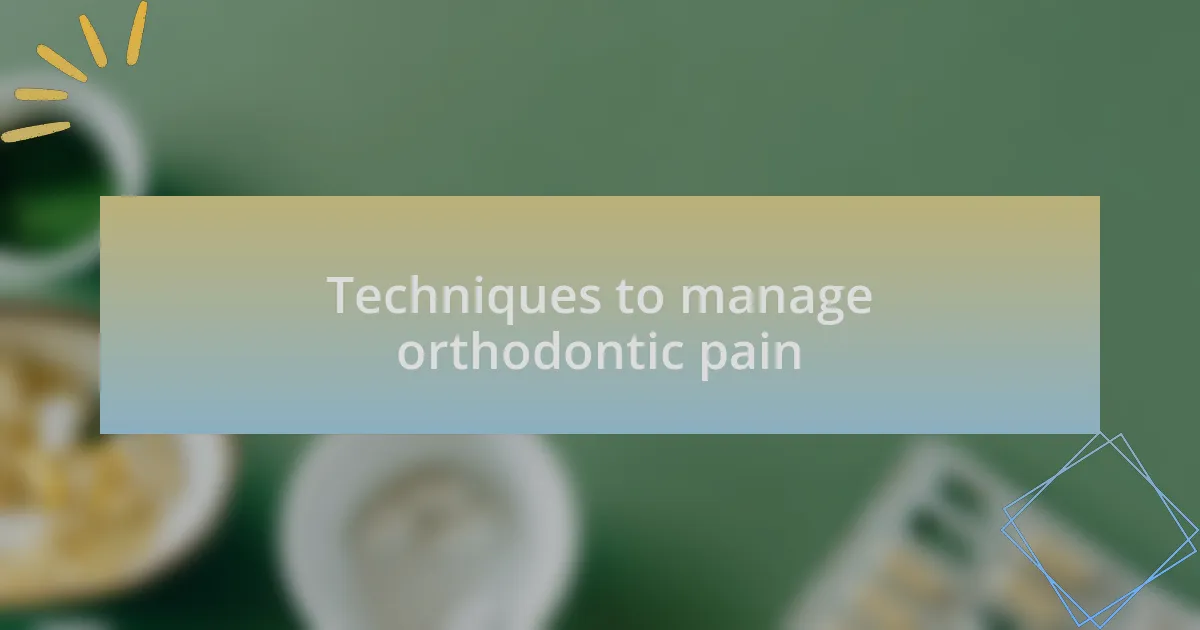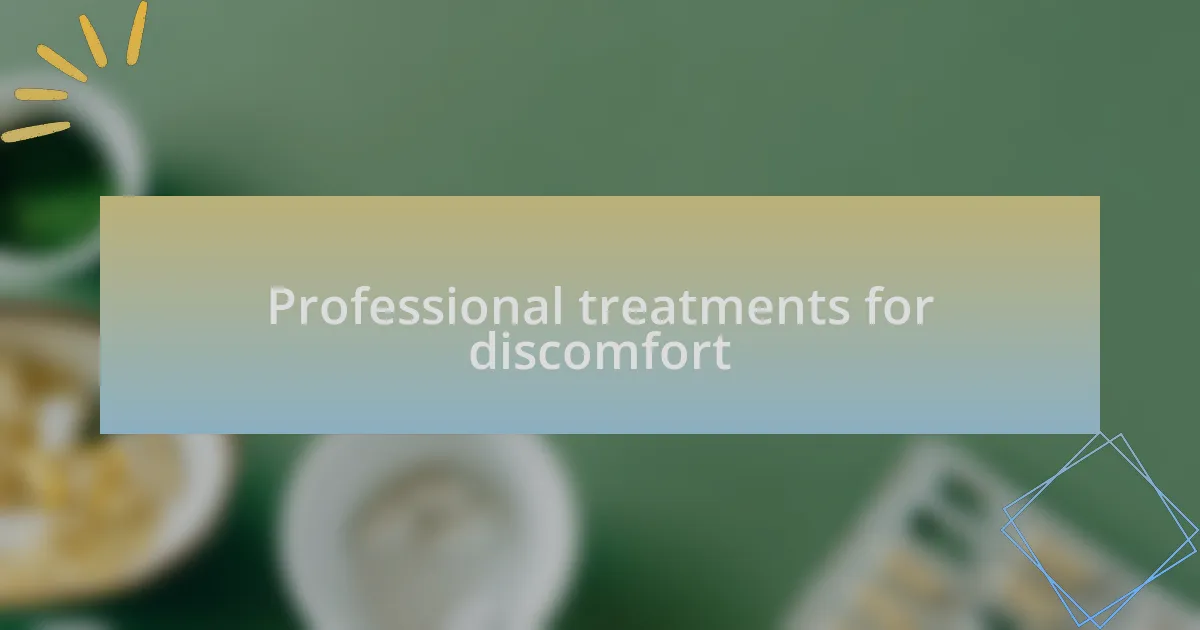Key takeaways:
- Orthodontic pain is common during braces adjustment, signaling progress, but it can cause discomfort due to pressure on gums and teeth.
- Managing pain can involve techniques like cold compresses, orthodontic wax, and over-the-counter pain relievers for relief.
- Home remedies, such as warm saltwater rinses and soft foods, along with staying hydrated, can help alleviate discomfort effectively.
- Professional treatments, including dental adjustments and topical numbing gels, provide significant relief and empower patients through pain management discussions.

Understanding orthodontic pain
Orthodontic pain can be quite a surprise for those new to braces. I remember the first few days after getting mine; it felt like a gentle but persistent pressure in my mouth. Have you ever experienced that growing sensation where it seems your teeth are trying to shift on their own? It’s a mix of discomfort and anticipation.
The source of this pain lies in the way braces work. As they adjust to align your teeth, they create tension on the gums and the bone surrounding the teeth. For me, the throbbing pain was a constant reminder that I was on a journey to a better smile, albeit a slightly uncomfortable one. I often found myself wondering if my teeth were really moving or just playing tricks on me.
It’s essential to understand that this pain, while annoying, signifies progress. Each creak and snap of the wires meant I was one step closer to my goal. I vividly recall sipping warm soup to soothe my aching gums after tightening appointments. In those moments, I asked myself: was it worth it? Looking back, I can confidently say yes; enduring that discomfort was pivotal in my path to achieving a beautiful smile.

Common causes of orthodontic pain
Orthodontic pain can often be attributed to the initial adjustment of braces and wires moving teeth into new positions. I remember feeling that nail-biting sensation when my orthodontist tightened the wires, leaving me wondering if it would ever feel normal again. It’s fascinating how each adjustment creates new pressure points that, while uncomfortable, are essential for achieving alignment.
Another common cause is the sensitivity that comes from the brackets and bands pressing against the cheeks and gums. The first few weeks wearing braces felt like I was constantly navigating a minefield in my mouth, avoiding anything that could irritate those tender spots. Have you ever felt like a dental acrobat, trying to eat without triggering that sharp twinge? That was my reality as I learned which foods to dodge until my mouth adjusted.
Lastly, the wear and tear on existing dental work, like crowns or fillings, can exacerbate discomfort during orthodontic treatment. I recall having to consult my orthodontist about a lingering ache that turned out to be linked to an old filling shifting slightly under the pressure of my braces. It made me realize how interconnected our dental health is, raising the question: could small issues become bigger hurdles during orthodontic treatment?

Techniques to manage orthodontic pain
Managing orthodontic pain can feel overwhelming, but I’ve discovered several techniques that can really make a difference. For instance, applying a cold compress to the outside of your cheeks can soothe inflammation and numb the area, providing quick relief after adjustments. I often relied on this method after appointments, feeling a wave of comfort as the coolness countered the throbbing pressure inside my mouth.
Another technique that helped me was using orthodontic wax. Initially, I felt unsure about applying it to my brackets, but once I did, it was a game changer. This simple layer of protection created a barrier between my sensitive gums and the sharp edges of the brackets, allowing me to relax and eat without constant anxiety about pain. Isn’t it amazing how such a small addition can transform the experience?
Lastly, I found that over-the-counter pain relievers became my ally during particularly challenging days. I remember definitely needing them after those tightening sessions that felt like a wrestling match in my mouth. Always checking with my orthodontist first was key; it helped me feel empowered to tackle discomfort while staying safe. Have you considered keeping your schedule flexible after orthodontic visits to gauge how you might need to manage pain effectively?

Home remedies for relief
Managing the discomfort from orthodontics can indeed be a challenge, but there are some effective home remedies that I found helpful. Rinsing my mouth with warm salt water became a soothing ritual during those tough days. I’d swirl it around gently, feeling the warmth ease my sore gums and bring a bit of relief. It’s interesting how something so simple can have such a calming effect, don’t you think?
Another remedy that surprised me was incorporating soft foods into my diet. I remember experimenting with smoothies, soups, and mashed potatoes. Not only did these options help me avoid aggravating any sensitive areas, but they also gave me a chance to explore new flavors without pain. It made me realize that adapting my meals could be both enjoyable and beneficial during my orthodontic journey.
Lastly, I found that staying hydrated played a pivotal role in my comfort. Sipping on water throughout the day seemed to help reduce inflammation and keep my mouth feeling fresh. There were times I would forget to drink enough, and I noticed that was when discomfort would creep in more intensely. Have you ever considered how hydration can impact your overall well-being during treatment? The connection is more significant than I initially thought.

Professional treatments for discomfort
When the discomfort from orthodontic work became overwhelming, I turned to professional treatments that provided significant relief. One effective option was visiting my orthodontist for adjustments. Each time, I would mention my discomfort, and they would apply specific techniques to alleviate pain, such as using dental wax or adjusting the braces. Feeling their expertise firsthand was reassuring, and it made a noticeable difference in my comfort levels.
Another professional treatment that came to my rescue was the application of topical numbing gels. I vividly recall the first time I experienced this—a small amount was applied directly to my gums, and within moments, the throbbing pain began to subside. I found myself wondering how a simple gel could transform my experience entirely. This quick solution was almost magical, making it easier to engage in daily activities without wincing in pain.
Finally, I appreciated the ability to discuss pain management options with my orthodontist. In one session, they recommended specific over-the-counter pain relief medications. This proactive approach empowered me; knowing I had a plan to combat discomfort helped me feel more in control of my treatment. Have you ever felt a sense of relief just by having a strategy in place? It gave me a renewed sense of confidence in my orthodontic journey.

Personal experiences with pain management
It’s interesting how everyone copes differently with pain. For me, while the orthodontic adjustments were essential, I found that the little things made a big impact, too. Listening to calming music while I iced my cheeks transformed a painful moment into a time for relaxation, and suddenly, the throbbing wasn’t as overwhelming as it had seemed.
I also remember one particularly rough night after tightening my braces. I was lying in bed, feeling that all-too-familiar ache, and I questioned whether I could manage through the discomfort. I decided to try a warm saltwater rinse based on a friend’s recommendation. The relief it brought was not just physical; it felt like I was reclaiming a bit of my comfort, reminding me that I could find solutions even during the toughest times.
There were moments when I pondered over my pain, wondering whether everyone experienced it the same way. I realized that sharing these experiences with friends undergoing similar treatments was incredibly soothing. Talking openly about pain not only validated my feelings but also strengthened my resolve to power through. Have you found that sharing your feelings about discomfort helped you cope better? I certainly did, and it created a support network I never expected to need.